The Rigid Box Market is estimated to be valued at USD 82.1 billion in 2025 and is projected to reach USD 98.1 billion by 2035, registering a compound annual growth rate (CAGR) of 1.8% over the forecast period.
The Rigid Box market is experiencing steady growth, driven by the increasing demand for premium and durable packaging solutions across food, beverage, and consumer goods industries. Rising consumer preference for high-quality packaging that enhances product presentation and protection is supporting adoption, while sustainability trends are encouraging the use of recyclable materials. The market is being further fueled by advancements in design technologies, printing capabilities, and automated manufacturing processes that improve efficiency and reduce production costs.
Growing e-commerce penetration has also increased the need for rigid packaging that ensures product integrity during transit. Companies are investing in customizable, aesthetically appealing rigid boxes to differentiate products and create brand recognition. The integration of innovative materials and coatings to enhance durability, functionality, and visual appeal is shaping market dynamics.
Regulatory requirements for safe and sustainable packaging are promoting the adoption of paper-based and recyclable materials As consumer demand for premium packaging solutions rises, the Rigid Box market is poised for sustained expansion, with innovation in materials, design, and production processes driving long-term growth.
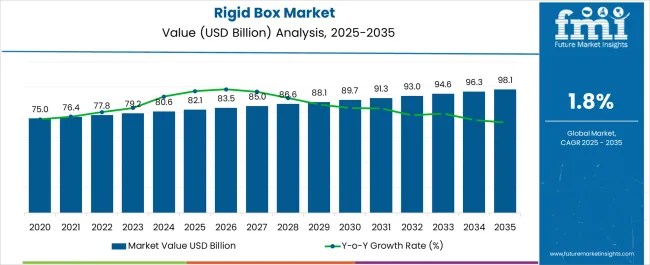
| Metric | Value |
|---|---|
| Rigid Box Market Estimated Value in (2025 E) | USD 82.1 billion |
| Rigid Box Market Forecast Value in (2035 F) | USD 98.1 billion |
| Forecast CAGR (2025 to 2035) | 1.8% |
The market is segmented by Product, Material, and End Use and region. By Product, the market is divided into Slotted Box, Folder Box, Telescope Box, and Die Cut Box. In terms of Material, the market is classified into Paper & Paperboard, Plastic, Metal, and Wood. Based on End Use, the market is segmented into Food & Beverages, Cosmetics & Personal Care, Electronics & Electricals, Healthcare, Chemicals & Fertilizers, and Other Consumer Goods. Regionally, the market is classified into North America, Latin America, Western Europe, Eastern Europe, Balkan & Baltic Countries, Russia & Belarus, Central Asia, East Asia, South Asia & Pacific, and the Middle East & Africa.
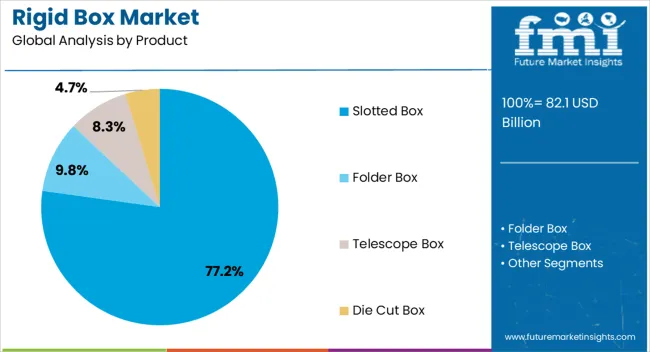
The slotted box product segment is projected to hold 77.2% of the market revenue in 2025, establishing it as the leading product type. Its dominance is driven by its versatility, ease of assembly, and suitability for a wide range of applications in packaging, particularly for shipping, storage, and retail display. Slotted boxes can be efficiently manufactured at scale while accommodating customization for brand-specific designs, which enhances their adoption.
Their compatibility with diverse materials, including paper and paperboard, further strengthens their position. The segment also benefits from the growing need for cost-effective yet durable packaging solutions that protect products during handling and transport. Companies leverage slotted boxes to enhance shelf appeal and ensure consumer satisfaction.
With the increasing trend toward sustainable packaging, slotted boxes made from recyclable and eco-friendly materials are experiencing higher adoption As demand continues to rise across commercial and consumer sectors, the slotted box segment is expected to maintain its leading position, supported by flexibility, scalability, and adaptability to evolving packaging requirements.
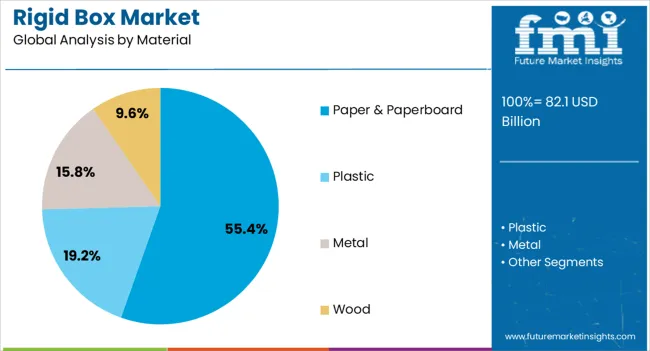
The paper and paperboard material segment is anticipated to account for 55.4% of the market revenue in 2025, making it the leading material category. Growth in this segment is being driven by the increasing focus on sustainability and environmentally friendly packaging solutions. Paper and paperboard offer advantages such as recyclability, ease of printing, and compatibility with various coating and lamination processes, which allow for high-quality visual appeal and durability.
This material is widely used in premium packaging for food, beverages, and consumer products, providing both protection and aesthetic value. The adoption is further reinforced by regulatory initiatives promoting biodegradable and recyclable packaging.
Manufacturers are leveraging paper and paperboard to create customized and branded rigid boxes that enhance product differentiation As consumer awareness and demand for sustainable packaging continue to rise, the paper and paperboard segment is expected to remain dominant, supported by its combination of environmental benefits, operational efficiency, and design flexibility.
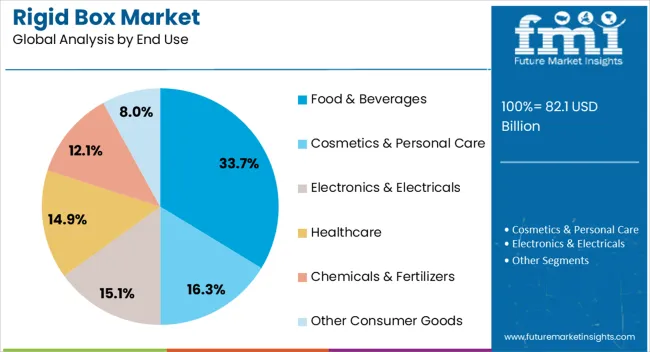
The food and beverages end-use segment is projected to hold 33.7% of the market revenue in 2025, establishing it as the leading application sector. Growth in this segment is being driven by the increasing need for secure, hygienic, and visually appealing packaging solutions that maintain product quality and freshness. Rigid boxes provide structural stability, protection from physical damage, and enhanced shelf presentation, which is critical for packaged food and beverage products.
Rising consumer preference for premium and gift packaging in confectionery, snacks, and beverage categories further supports adoption. Manufacturers are leveraging rigid boxes to enhance brand image, improve consumer experience, and ensure compliance with food safety regulations.
Innovations in material coatings, lamination, and printing technologies are enabling better protection and aesthetic appeal while maintaining sustainability As demand for packaged food and beverages continues to rise globally, the segment is expected to maintain its leading market position, driven by the need for durable, customizable, and consumer-friendly packaging solutions.
In 2020, the global rigid box market was estimated to reach a valuation of USD 75 billion. The rigid box market witnessed significant growth, registering a CAGR of 1.2% during the historical period 2020 to 2025.
| Historical CAGR | 1.2% |
|---|---|
| Forecast CAGR | 1.8% |
The rigid box market expanded throughout these years due to the escalating need for high-end packaging solutions across several industries and the interest in brand differentiation. The growth rate stayed low, indicating that market size and revenue were on the verge of expanding steadily rather than quickly.
The demand for sturdy packing options ensured product safety during transit and was majorly driven by current trends, like the accelerating popularity of e-commerce, reflected in the projected rise.
Manufacturers anticipate changing market dynamics by providing more recyclable and biodegradable rigid box options in response to the growth in emphasis on sustainability and eco-friendly packaging options.
The below section shows the leading segment. Based on the product, the slotted box segment is accounted to hold a market share of 77.2% in 2025. Based on material, the paper and paperboard segment is accounted to hold a market share of 55.4% in 2025.
Affordability and adaptability widely surge the demand for the slotted boxes. Paper and paperboard packaging materials are becoming increasingly popular due to regulatory pressure and concerns about sustainability.
| Category | Market Share in 2025 |
|---|---|
| Slotted Box | 77.2% |
| Paper and Paperboard | 55.4% |
Based on product, the slotted box segment dominates the packaging market, capturing a substantial market share of 77.2%.
Slotted boxes are largely preferred for their versatility and cost-effectiveness across various industries, including e-commerce, retail, and logistics. The simple yet sturdy design makes them suitable for packaging various products, from consumer goods to industrial equipment.
With the continuous growth in online shopping and global trade, the demand for slotted boxes remains robust, driving their significant market presence.
Based on materials, the paper and paperboard segment emerges as the leading material choice, holding a substantial market share of 55.4%. Paper and paperboard offer several advantages, including recyclability, lightweight, and versatility, making them ideal for sustainable packaging solutions.
With a boom in environmental concerns and regulations promoting eco-friendly packaging, the demand for paper and paperboard packaging continues to rise across industries such as food and beverage, healthcare, and personal care.
The dominance in the market underscores the escalating preference for environmentally responsible packaging materials.
The table mentions the top five countries ranked by revenue, with India holding the top position. Due to the accelerating need for high-end packaging solutions in various industries, including jewelry, clothing, cosmetics, and fast-moving consumer goods, India is considered to be leading the rigid box market.
The producers of India are adapting to fulfil the demand for long-lasting and aesthetically beautiful packaging due to changing consumer preferences and rising disposable income.
Forecast CAGRs from 2025 to 2035
| Countries | CAGR through 2035 |
|---|---|
| The United States | 0.5% |
| Canada | 0.4% |
| China | 4.3% |
| Spain | 2.4% |
| India | 5.1% |
Rigid boxes are extensively used in the United States across various industries, such as cosmetics, luxury goods, electronics, and consumer packaged goods. Strong and premium packaging solutions enhance product presentation and offer superior protection during transit.
In the United States market, rigid boxes are often utilized for high-end products where brand image and customer experience are paramount, driving demand from both manufacturers and consumers.
The rigid box market in Canada is predominantly utilized in sectors like cosmetics, confectionery, spirits, and premium food products. Rigid boxes are valued for their durability and visual appeal, making them ideal for packaging luxury items and gift sets.
The market in Canada sees significant usage of rigid boxes in the retail sector, particularly for limited edition or seasonal promotions.
The market in China demonstrates a demand for rigid boxes across various industries, including electronics, cosmetics, health supplements, and luxury goods. Rigid boxes are favored for their ability to convey prestige and quality, aligning with consumers’ growth in affinity for premium products.
With the surge of e-commerce, rigid boxes play a crucial role in the enhancement of the unboxing experience and differentiating brands in a competitive market landscape.
The rigid box market in Spain is prominently utilized in the fashion, wine and spirits, gourmet food, and luxury sectors. Rigid boxes serve as a symbol of elegance and sophistication, particularly in industries where presentation is paramount.
The consumers of Spain often associate rigid box packaging with premium quality, making it a popular choice for upscale products and gift packaging.
The market experiences significant utilization in various sectors like apparel and FMCG (Fast Moving Consumer Goods). Rigid boxes are widely appreciated for their ability to elevate brand perception and provide a premium unboxing experience.
With the gain in disposable income and changing consumer preferences in India, the demand for exquisite and durable packaging solutions like rigid boxes is surging, especially among urban consumers.
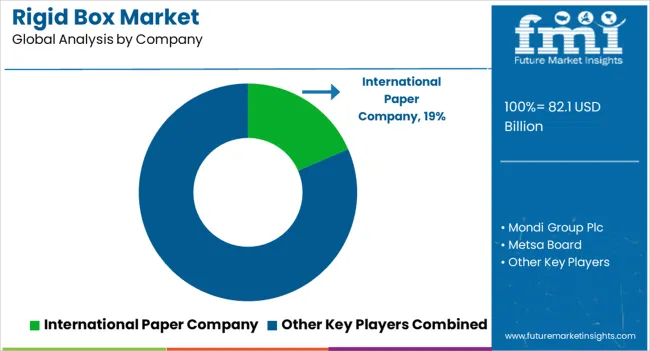
Key competitors in the rigid box industry fight for market share through service, quality, and innovative product offers in a fiercely competitive market.
The rigid box market is still competitive and active due to the thriving demand for luxury goods, electronics, cosmetics, and other high-end packaging across various industries. This has prompted industry participants to form strategic alliances and continuously innovate.
Key Developments in the Rigid Box Industry
| Attributes | Details |
|---|---|
| Estimated Market Size in 2025 | USD 82.1 billion |
| Projected Market Valuation in 2035 | USD 98.1 billion |
| Value-based CAGR 2025 to 2035 | 1.8% |
| Forecast Period | 2025 to 2035 |
| Historical Data Available for | 2020 to 2025 |
| Market Analysis | Value in USD billion |
| Key Regions Covered | North America; Latin America; Western Europe; Eastern Europe; South Asia and Pacific; East Asia; The Middle East and Africa |
| Key Market Segments Covered | Product, Material, End Use, Region |
| Key Countries Profiled | The United States, Canada, Brazil, Mexico, Germany, The United Kingdom, France, Spain, Italy, Russia, Poland, Czech Republic, Romania, Rest of Eastern Europe, India, Bangladesh, Australia, New Zealand, China, Japan, South Korea, GCC countries, South Africa, Israel |
| Key Companies Profiled | International Paper Company; Mondi Group Plc; Metsa Board; Bee Packaging; Tat Seng Packaging Group Ltd.; Stora Enso Oyj; Smurfit Kappa Group Plc; Shillington Box Co., LLC; Great Little Box Company Ltd.; Georgia Pacific LLC |
The global rigid box market is estimated to be valued at USD 82.1 billion in 2025.
The market size for the rigid box market is projected to reach USD 98.1 billion by 2035.
The rigid box market is expected to grow at a 1.8% CAGR between 2025 and 2035.
The key product types in rigid box market are slotted box, folder box, telescope box and die cut box.
In terms of material, paper & paperboard segment to command 55.4% share in the rigid box market in 2025.






Our Research Products

The "Full Research Suite" delivers actionable market intel, deep dives on markets or technologies, so clients act faster, cut risk, and unlock growth.

The Leaderboard benchmarks and ranks top vendors, classifying them as Established Leaders, Leading Challengers, or Disruptors & Challengers.

Locates where complements amplify value and substitutes erode it, forecasting net impact by horizon

We deliver granular, decision-grade intel: market sizing, 5-year forecasts, pricing, adoption, usage, revenue, and operational KPIs—plus competitor tracking, regulation, and value chains—across 60 countries broadly.

Spot the shifts before they hit your P&L. We track inflection points, adoption curves, pricing moves, and ecosystem plays to show where demand is heading, why it is changing, and what to do next across high-growth markets and disruptive tech

Real-time reads of user behavior. We track shifting priorities, perceptions of today’s and next-gen services, and provider experience, then pace how fast tech moves from trial to adoption, blending buyer, consumer, and channel inputs with social signals (#WhySwitch, #UX).

Partner with our analyst team to build a custom report designed around your business priorities. From analysing market trends to assessing competitors or crafting bespoke datasets, we tailor insights to your needs.
Supplier Intelligence
Discovery & Profiling
Capacity & Footprint
Performance & Risk
Compliance & Governance
Commercial Readiness
Who Supplies Whom
Scorecards & Shortlists
Playbooks & Docs
Category Intelligence
Definition & Scope
Demand & Use Cases
Cost Drivers
Market Structure
Supply Chain Map
Trade & Policy
Operating Norms
Deliverables
Buyer Intelligence
Account Basics
Spend & Scope
Procurement Model
Vendor Requirements
Terms & Policies
Entry Strategy
Pain Points & Triggers
Outputs
Pricing Analysis
Benchmarks
Trends
Should-Cost
Indexation
Landed Cost
Commercial Terms
Deliverables
Brand Analysis
Positioning & Value Prop
Share & Presence
Customer Evidence
Go-to-Market
Digital & Reputation
Compliance & Trust
KPIs & Gaps
Outputs
Full Research Suite comprises of:
Market outlook & trends analysis
Interviews & case studies
Strategic recommendations
Vendor profiles & capabilities analysis
5-year forecasts
8 regions and 60+ country-level data splits
Market segment data splits
12 months of continuous data updates
DELIVERED AS:
PDF EXCEL ONLINE
Rigid Sleeve Boxes Market Size and Share Forecast Outlook 2025 to 2035
Luxury Rigid Box Market Size and Share Forecast Outlook 2025 to 2035
Market Share Breakdown of Luxury Rigid Box Manufacturers
Box Liners Market Size and Share Forecast Outlook 2025 to 2035
Rigid Foam Market Forecast Outlook 2025 to 2035
Rigid Food Containers Market Size and Share Forecast Outlook 2025 to 2035
Boxboard Packaging Market Analysis - Size, Share, and Forecast Outlook 2025 to 2035
Rigid IBC Market Size and Share Forecast Outlook 2025 to 2035
Box Compression Tester Market Size and Share Forecast Outlook 2025 to 2035
Rigid-Flex PCB Market Size and Share Forecast Outlook 2025 to 2035
Rigid Metal Electrical Conduit Market Size and Share Forecast Outlook 2025 to 2035
Box Latch Market Size and Share Forecast Outlook 2025 to 2035
Rigid Food Packaging Market Size, Share & Forecast 2025 to 2035
Rigid Industrial Packaging Market Size, Share & Forecast 2025 to 2035
Box Pouch Market by Pouch Type from 2025 to 2035
Box Filling Machine Market from 2025 to 2035
Box and Carton Overwrap Films Market Demand and Growth
Box and Carton Overwrapping Machines Market Insights and Growth 2025 to 2035
Boxcar Scars Market – Demand, Growth & Forecast 2025 to 2035
Box Sealing Machines Market Trends – Growth & Forecast 2025 to 2035

Thank you!
You will receive an email from our Business Development Manager. Please be sure to check your SPAM/JUNK folder too.
Chat With
MaRIA